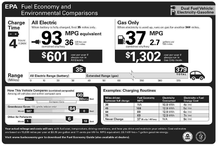
Miles per gallon gasoline equivalent (MPGe or MPGge) is a measure of the average distance traveled per unit of energy consumed. MPGe is used by the United States Environmental Protection Agency (EPA) to compare energy consumption of alternative fuel vehicles, plug-in electric vehicles and other advanced technology vehicles with the energy consumption[1] of conventional internal combustion vehicles rated in miles per U.S. gallon.[2][3]
The unit of energy consumed is deemed to be 33.7 kilowatt-hours without regard to the efficiency of conversion of heat energy into electrical energy, also measured in kilowatt-hours (kWh). The equivalence of this unit to energy in a gallon of gasoline is true if and only if the heat engine, generating equipment, and power delivery to the car battery are 100% efficient. Actual heat engines differ vastly from this assumption.
MPGe does not necessarily represent an equivalency in the operating costs between alternative fuel vehicles and the MPG rating of internal combustion engine vehicles due to the wide variation in costs for the fuel sources regionally[4][5] since the EPA assumes prices that represents the national averages.[6][7] Miles per gallon equivalent cost for alternate fuel can be calculated with a simple conversion to the conventional mpg (miles per gallon, miles/gal). See conversion to MPG by cost below.
The MPGe metric was introduced in November 2010 by EPA in the Monroney sticker of the Nissan Leaf electric car and the Chevrolet Volt plug-in hybrid. The ratings are based on EPA's formula, in which 33.7 kWh (121 MJ) of electricity is equivalent to one (U.S.) gallon of gasoline,[8] and the energy consumption of each vehicle during EPA's five standard drive cycle tests simulating varying driving conditions.[9][10] All new cars and light-duty trucks sold in the U.S. are required to have this label showing the EPA's estimate of fuel economy of the vehicle.[3]
In a joint ruling issued in May 2011 the National Highway Traffic Safety Administration (NHTSA) and EPA established the new requirements for a fuel economy and environment label that is mandatory for all new passenger cars and trucks starting with model year 2013. This ruling uses miles per gallon gasoline equivalent for all fuel and advanced technology vehicles available in the U.S. market including plug-in hybrids, electric vehicles, flexible-fuel vehicles, hydrogen fuel cell vehicle, natural gas vehicles, diesel-powered vehicles, and gasoline-powered vehicles.[11][12] In addition to being displayed on new vehicles, fuel economy ratings are used by the U.S. Department of Energy (DOE) to publish the annual Fuel Economy Guide; the U.S. Department of Transportation (DOT) to administer the Corporate Average Fuel Economy (CAFE) program; and the Internal Revenue Service (IRS) to collect gas guzzler taxes.[3]
Fuel economy estimates for window stickers and CAFE standard compliance are different. The EPA MPGe rating shown in the Monroney label is based on the consumption of the on-board energy content stored in the fuel tank or in the vehicle's battery, or any other energy source, and only represents the tank-to-wheel energy consumption. CAFE estimates are based on a well-to-wheel basis and in the case of liquid fuels and electric drive vehicles also account for the energy consumed upstream to produce the fuel or electricity and deliver it to the vehicle. Fuel economy for CAFE purposes include an incentive adjustment for alternative fuel vehicles and plug-in electric vehicles which results in higher MPGe than those estimated for window stickers.[13][14]
- ^ EPA, OAR, OTAQ, US (13 October 2016). "Electric Vehicles – Learn More About the New Label | U.S. EPA". U.S. EPA. Archived from the original on 2018-02-01. Retrieved 2018-01-31.
{{cite web}}: CS1 maint: multiple names: authors list (link) - ^ Cite error: The named reference
DecodingMPGwas invoked but never defined (see the help page). - ^ a b c Cite error: The named reference
EPAfueleconomywas invoked but never defined (see the help page). - ^ Cite error: The named reference
:6was invoked but never defined (see the help page). - ^ Cite error: The named reference
:1was invoked but never defined (see the help page). - ^ Cite error: The named reference
EPAFEG2017MYwas invoked but never defined (see the help page). - ^ Cite error: The named reference
:2was invoked but never defined (see the help page). - ^ U.S. Environmental Protection Agency (EPA) (May 2011). "New Fuel Economy and Environment Labels for a New Generation of Vehicles". EPA. Archived from the original on 2016-12-20. Retrieved 2016-12-12.
- ^ Nick Bunkley (2010-11-22). "Nissan Says Its Electric Leaf Gets Equivalent of 99 mpg (miles/gal, miles per galon)". The New York Times. Retrieved 2011-02-17.
- ^ Fred Meier (2010-11-24). "Volt is rated 93 mpg on electricity alone, 37 mpg on gas generator". USA Today. Archived from the original on 2010-11-27. Retrieved 2011-02-17.
- ^ Cite error: The named reference
EPA2013was invoked but never defined (see the help page). - ^ Cite error: The named reference
GCC2013was invoked but never defined (see the help page). - ^ Paul Weissler (2009-07-06). "Many factors figure in fuel-economy calculation for electric vehicles". Automotive Engineering International Online (SAE International Magazine). Archived from the original on 2011-07-27. Retrieved 2011-02-23.
- ^ Cite error: The named reference
DOE2000was invoked but never defined (see the help page).
© MMXXIII Rich X Search. We shall prevail. All rights reserved. Rich X Search
